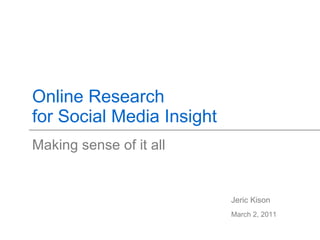Online research for social media insight
- 1. Online Research for Social Media Insight Making sense of it all Jeric Kison March 2, 2011
- 2. Insights Likes Retweets Clickthrough rates Impressions Followers Fans Views Comments Replies Ratings
- 3. Insights Perceptions Awareness Understanding Perspective Actionable
- 4. Agenda 1 Why use social media for research? 2 What can we learn from social media? 3 How do we leverage social media?
- 5. Why use social media for research?
- 6. Traditional methods are limited Artificial Inaccurate Obtrusive Expensive
- 7. Social mediaŌĆÖs advantages Natural Relevant Accessible Cost-effective
- 8. TheyŌĆÖre complementary Traditional Online
- 9. What can we learn from social media?
- 13. How do we leverage social media?
- 14. Select Source: http://www.theconversationprism.com/
- 15. Listen
- 16. Consolidate
- 17. Act
- 18. Some final insights 1 Traditional research methods have limitations, a lot of which are overcome by social media 2 Social media provide a rich source of relevant and valuable information 3 Researching via social media requires a significant investment in time and effort
- 19. Thank you! Feel free to post your comments and questions!
Editor's Notes
- #3: Over the past few years, a new industry has emerged out of the need for insights online. Online research firms claim to provide clients with valuable insights to grow their business and give lots of numbers. But thatŌĆÖs not all there is to it.
- #4: Insights for marketing research are more about these: Awareness of broader market and consumer trends Perspective of consumer behaviour in context Perception of deeper meanings Understanding of underlying motivations Acting on strategy ŌĆō e.g. Change in advertising strategy or product design ItŌĆÖs more than just knowing that your YouTube video generated over 1,000,000 views this month. ItŌĆÖs discovering, for example, that all you needed to sell some Kraft Mac & Cheese was a guy with a golden voice. Then you decide, I probably should use the guy for all my other commercials.
- #7: Artificial because responses are elicited. People would often think twice about a certain response. Inaccurate because your sample might not be truly representative of your target market. Obtrusive because itŌĆÖs disruptive. Expensive just because they can be difficult to implement on a wide scale with limited resources.
- #8: All the opposite. Natural because people just naturally share their experiences online Relevant because the technology allows for targeted information Accessible because the needed information is public and instant Cost-effective because of accessibility and scalability
- #9: LetŌĆÖs be clear: social media research is not meant to replace traditional methods but rather to complement. Both can offer different insights which can be useful for marketers.
- #11: Social media provides a lot of rich data about consumers. However, itŌĆÖs more than just knowing who the customer is but what he does, who he is connected to and how he interacts as well.
- #12: ItŌĆÖs more than just ticking off ŌĆ£dissatisfiedŌĆØ on a survey. ItŌĆÖs about consumers elaborating on their product experiences in a way thatŌĆÖs instructive.
- #13: ItŌĆÖs more than just knowing that you have over 1.3 million fans. ItŌĆÖs knowing how those fans truly feel about your brand.
- #14: The nature of the online sphere requires marketers to make considerations in addition to those that they use for traditional research methods.
- #15: Different media provide different kinds of information (e.g. Facebook posts versus Twitter posts). Marketing researchers must know which platforms provide the most relevant information to achieve their objectives.
- #16: Information is constantly being published in real-time and so marketing research must occur constantly as well. Take JC PenneyŌĆÖs recent logo change for example. Marketing researchers must be follow online conversations closely to gauge consumersŌĆÖ responses and pre-empt any Gap-style backlashes. (Check out the new JC Penney logo: they used exactly the same font as the new Gap logo!)
- #17: A lot of information can be generated from the listening process. Marketing researchers must filter through the massive amounts of information and consolidate the most useful bits that achieve their objectives. Thankfully, technology exists today that allows for the automation of the consolidation process.
- #18: Do something about the information! ThatŌĆÖs what Gap did in response to the consumer backlash against its new (now-defunct logo). The wealth of information should provide a solid basis for making key strategic decisions.
- #19: This is not to say, however, that social media research should replace traditional research methods. Make sure to get the right info that achieves your marketing research objectives. In an age of instant and ubiquitous information, time is of the essence. Miss a secondŌĆÖs worth of information and youŌĆÖre already behind.



















